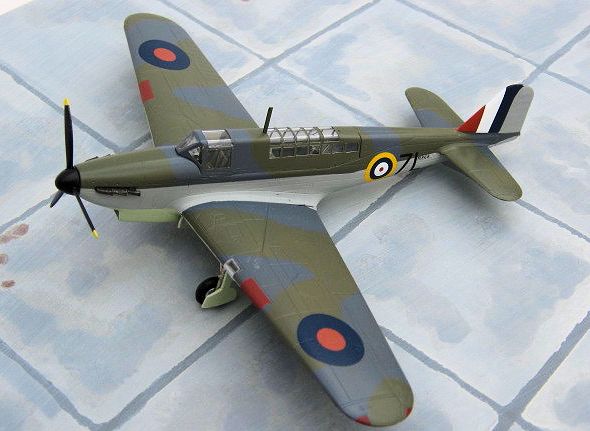
Airfix 1/72 Fulmar I
| KIT #: | A02008 |
| PRICE: |
£6-99 |
| DECALS: | Two options |
| REVIEWER: | Frank Reynolds |
| NOTES: | Reboxed Vista kit |

| HISTORY |
Some aircraft from World War Two
seem
destined to be
permanently under-rated; less glamorous perhaps than cutting edge fighters
or heavy bombers, their exploits confined to less spectacular campaigns or
perhaps employed in the early war period when defeat was more common than
victory. The Fairey Fulmar encompasses some of these factors for history
tends to treat its contributions as footnotes in the story of Allied
victory. Yet the record shows that it was an excellent aircraft for its
time, in battle it had a surprisingly good kill ratio and it served the
Royal Navy’s Fleet Air Arm in significant numbers.
The Fulmar originated in response
to a technical requirement issued to Britain’s aircraft manufacturers in
1938, in a remarkably far-sighted move to provide the fleet with a fighter
that had a similar eight .303in gun armament to RAF types of the period such
as the Hurricane or Spitfire. Contemporary thinking dictated that the
aircraft should carry an Observer (navigator) to assist the pilot in long
over water lights. The result was a purpose-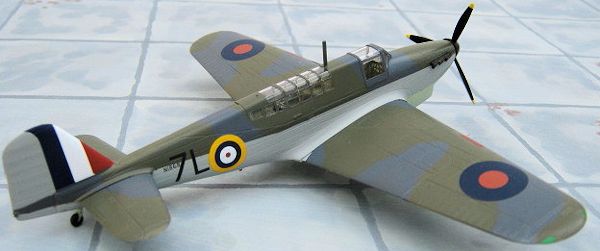 built
naval aircraft, not a landplane lash up hastily adapted for naval use. Deck
arrester gear, catapult spools, folding wings and naval equipment were all
incorporated. Fitted with a 1,300hp Rolls Royce Merlin engine and with an
all up weight of 10,000lbs the Fulmar was, at 230 mph maximum cruising
speed,
a full 100mph slower than a Spitfire or similar single seat
fighter of the period. It was, however, a sweet flying machine and not
difficult to land on a carrier deck. It is also remarkable for the speed
with which it went into service for the first prototype flew on January 4
1940 and the first production aircraft were in combat in the Mediterranean
theatre in September of the same year.
built
naval aircraft, not a landplane lash up hastily adapted for naval use. Deck
arrester gear, catapult spools, folding wings and naval equipment were all
incorporated. Fitted with a 1,300hp Rolls Royce Merlin engine and with an
all up weight of 10,000lbs the Fulmar was, at 230 mph maximum cruising
speed,
a full 100mph slower than a Spitfire or similar single seat
fighter of the period. It was, however, a sweet flying machine and not
difficult to land on a carrier deck. It is also remarkable for the speed
with which it went into service for the first prototype flew on January 4
1940 and the first production aircraft were in combat in the Mediterranean
theatre in September of the same year.
The Navy had
not anticipated going to war against land-based enemy fighters so the Fulmar
had what was considered an adequate specification for protecting naval
assets against probable threats such as enemy long range bombers. The
ammunition carried, at 750 rounds per gun, was twice that of a Spitfire of
the period and the patrol endurance of five hours was comfortably in excess
of that of a single seat fighter. So, heavy with the extra crew member, the
weight of ammunition and fat with fuel the Fulmar was never expected to be a
twinkle-toed dog fighter, but it was a rugged and efficient armed
reconnaissance and fleet defence aircraft that could hold off enemy bombers.
Unusually for the time, the occupant of the rear cockpit was provided with
no defensive armament, although in service some squadrons unofficially
provided a hand held Thompson sub-machine gun for emergency use.
The Fulmar
II was fitted with a 1260hp Merlin 30 engine, intended to provide
commonality with the Navy’s planned Barracuda strike bomber and could be
distinguished externally for the Mark.I by external tropical filters located
on the sides of the nose intake.
The Fulmar
gained its honours in th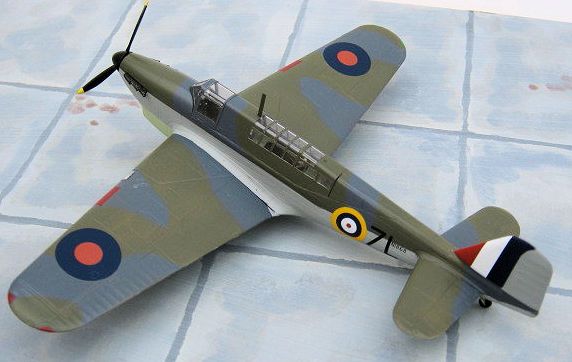 e
Eastern Mediterranean Sea throughout 1941 and 1942. Support for the besieged
island of Malta was only possible through convoy support and aircraft
ferrying though Gibraltar and Fulmar squadrons were in the thick of the
action, at times acting as navigational guides for groups of Hurricanes and
Spitfires on their long overwater journey to the island. Nos 803 and 806
sqn.s operated from the carrier Formidable during the vicious battle for
Crete, claiming 56 enemy aircraft destroyed. The Fulmar operated on
anti-submarine patrols in the Straits of Gibraltar where its long loiter
time and heavy forward armament could be put to good effect. 809 and 844
Sqns from the Victorious provided low level fleet cover for the vital
Operation Pedestal relief convoy to Malta, in August 1942.
e
Eastern Mediterranean Sea throughout 1941 and 1942. Support for the besieged
island of Malta was only possible through convoy support and aircraft
ferrying though Gibraltar and Fulmar squadrons were in the thick of the
action, at times acting as navigational guides for groups of Hurricanes and
Spitfires on their long overwater journey to the island. Nos 803 and 806
sqn.s operated from the carrier Formidable during the vicious battle for
Crete, claiming 56 enemy aircraft destroyed. The Fulmar operated on
anti-submarine patrols in the Straits of Gibraltar where its long loiter
time and heavy forward armament could be put to good effect. 809 and 844
Sqns from the Victorious provided low level fleet cover for the vital
Operation Pedestal relief convoy to Malta, in August 1942.
Fulmars were
withdrawn from the squadrons in early 1943 as faster and more agile Seafires
became available. Small numbers were converted to night fighters for trails
and training use but it was never employed as a front line night fighter.
Some 600
Fulmars were built (250 Mk.I, 350 MK.II.), yet only 40 are recorded as lost
to enemy action in combat. Over 125 enemy aircraft were claimed as victories
by Fulmars – more than any other British naval aircraft.
| THE KIT |
This kit had
been languishing on the shelves of my LHS for over two years when it finally
persuaded me to take it home.
The
mouldings seem to have appeared under a number of different labels in recent
years originating with Vista in Eastern Europe and variously boxed by Smer,
Revell and , as in this case, Airfix.
Outside of snap and fix kits,
they do not come much simpler than this offering.
Just 37
parts in pale grey plastic of medium density and three in clear. Surface
detail is engraved in a crisp and reasonably subtle manner, with just a
trace of flash around some of the parts that was easily stroked away with a
scalpel blade. Instructions are an 8-page A4 booklet in greyscale and the
standard kit offers two colour f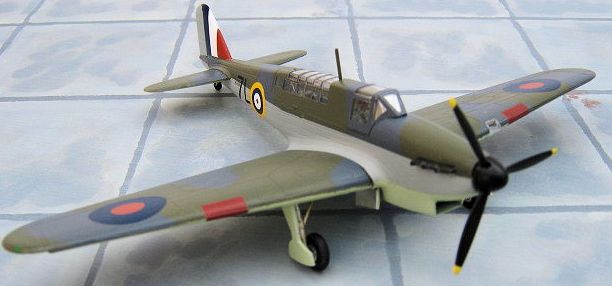 inishes.
First is a standard 1941 scheme for a Fulmar I of 806 Sqn. of HMS
Illustrious, 1941, with upper surfaces of Extra Dark
Sea Grey and Dark Slate Grey over Sky under surfaces. The second is the
rarer NF. MkII night fighter in RAF-style camouflage of overall Sea Grey
Medium with Dark Green patches over the upper surfaces. This is from the
shore based training squadron, no. 784 from Royal Naval Air Station
Donibristle, 1944. Decals are nicely printed with good register and the
colours, particularly the dull red of the national insignia are convincing
for the period. However the sheet is simple and no airframe stencilling is
provided.
inishes.
First is a standard 1941 scheme for a Fulmar I of 806 Sqn. of HMS
Illustrious, 1941, with upper surfaces of Extra Dark
Sea Grey and Dark Slate Grey over Sky under surfaces. The second is the
rarer NF. MkII night fighter in RAF-style camouflage of overall Sea Grey
Medium with Dark Green patches over the upper surfaces. This is from the
shore based training squadron, no. 784 from Royal Naval Air Station
Donibristle, 1944. Decals are nicely printed with good register and the
colours, particularly the dull red of the national insignia are convincing
for the period. However the sheet is simple and no airframe stencilling is
provided.
Parts are
provided for both Mk.I and Mk.II versions, whereby the MK.II has two
additional cheek intakes to the sides of the lower nose intake. The
instructions also note that the Mk.II night fighter version requires two
small exhaust flame dampers to be made from thin card
| CONSTRUCTION |
Commencing
with one long floor section that reaches from the pilot’s cockpit through to
the observer’s rear compartment, the interior is simplicity itself. The
pilot has a seat, control stick and rudder pedals, the observer a bucket
seat only. Two small bulkheads divide the front and rear compartments and a
small instrument panel completes the interior. I decided to keep it all
simple for this build with minimal alteration so the crew seats were treated
to seat belts fashioned from masking tape and nothing further. The interior
was painted in Xtracrylix XA1010 Aircraft Grey Green, with the instrument
panel picked out in black and the seat belts in a dark brown wash. The
fuselage halves were quickly closed up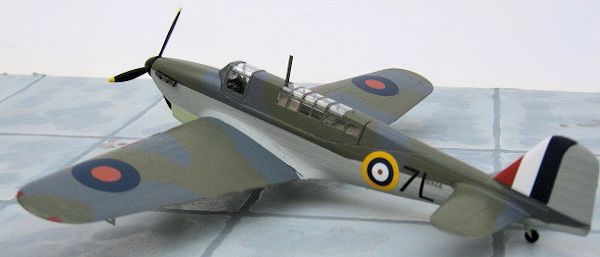 ,
adding a small blanking plate within the nose intake and an insert in the
lower rear fuselage which incorporates the arrester hook housing. Throughout
the build I was impressed with the good fit and positive location of the
parts. This is a well-engineered kit. The wing consists of a one piece full
span lower section with separate upper wing halves, simple and effective
with no worries about setting dihedral. The only real limitation of this kit
is the see-through wheel wells, so the edges of the wells were lined with
strips of plastic card as a representation of the wing’s internal structure.
I made a small modification under the centre section where the mould maker
has formed a pair of solid triangles to represent the catapult spools and I
substituted two sections of plastic rod to hint at the tubular framing that
exists in this area.
,
adding a small blanking plate within the nose intake and an insert in the
lower rear fuselage which incorporates the arrester hook housing. Throughout
the build I was impressed with the good fit and positive location of the
parts. This is a well-engineered kit. The wing consists of a one piece full
span lower section with separate upper wing halves, simple and effective
with no worries about setting dihedral. The only real limitation of this kit
is the see-through wheel wells, so the edges of the wells were lined with
strips of plastic card as a representation of the wing’s internal structure.
I made a small modification under the centre section where the mould maker
has formed a pair of solid triangles to represent the catapult spools and I
substituted two sections of plastic rod to hint at the tubular framing that
exists in this area.
The
horizontal tails were added next and the basic airframe left overnight to
dry before some light attention from sanding sticks and a coat of grey auto
primer from a rattle can. No significant areas of filler were found to be
necessary.
| COLORS & MARKINGS |
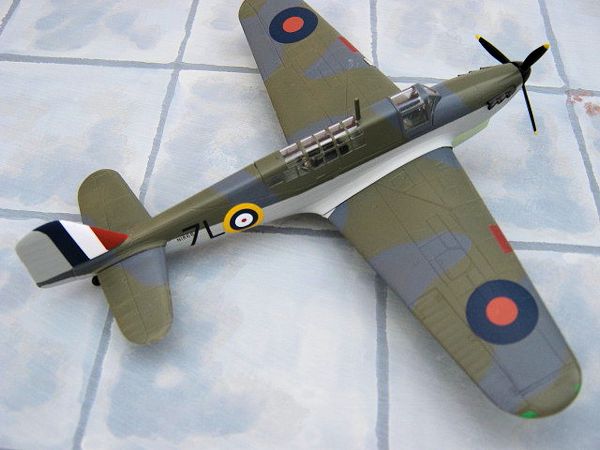 elements
of all three phases of camouflage.
elements
of all three phases of camouflage.
I used
Xtracrylix XA 1005 Extra Dark Sea Grey, XA1007 Sky and XA1025 Dark Slate
Grey. For the Sky Grey I used Tamiya XF-80 Royal Light Grey. This four
colour scheme required a little more masking than usual, but nothing too
difficult, although masking the 23 separate areas of glazing on the canopy
provided a separate evening’s entertainment.
The exhaust
pipes were picked out in dark bronze with a dark colour wash. The propeller
and spinner were Tamiya XF-1 Black with the prop tips picked out in yellow.
The airframe was airbrushed with my Iwata HP-C and the paint overlaid with a
brush coat of Future/Klear in preparation for the decals, which went on
without any drama, having good adhesion and colour density. The only
challenge came in getting the large tail fin red/white/blue decals to
conform without leaving a nasty join at the leading edge and in the end I
resorted to using two sets, one from the Hannants aftermarket sheet and one
from the kit-supplied Airfix set to get satisfactory coverage. The colours
from each sheet matched perfectly, suggesting that they may be from the same
source. I used off cuts from the unused roundels to make the red-brown
patches on the wing leading edges that cover the gun apertures.
The decals
and paintwork were sealed in with an air brushed coat of Xtracrylix Flat
varnish.
| FINAL CONSTRUCTION |
The three-strut
main gear legs are stoutly moulded in one piece and have a good positive fit
in the wheel wells. Main gear doors are moulded in one piece and the inner
and outer sections have to be separated but this is easily done with a
straight cut from a scalpel blade.
Then it was just
a case of adding the prominent landing light in the leading edge, roof
aerial, pitot tube under the Port wing, tail wheel and the arrester hook
| CONCLUSIONS |
Simple,
straightforward, stress-free and fun. What more could I ask from a project?
Low cost too. Recommended.
Today, the
sole remaining Fulmar is on public display at the Fleet Air Arm Museum,
Yeovilton, England. It is the first prototype, which survived as a Fairey
company communications aircraft post-war, being f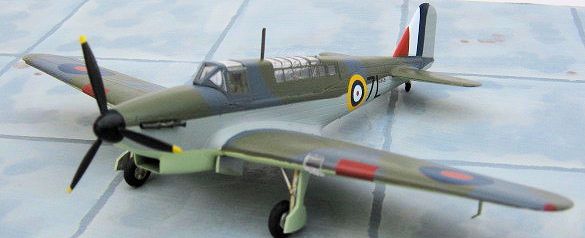 inally
retired for museum display in 1962. Today it sits, quiet and unassuming,
with its wings folded along its flanks, in a tight space that links two
galleries of that fine aviation museum. Visitors can sweep past, eager to
see the Avenger, Hellcat, Sea Fury or Seafire in the main display. There is
just the faintest hint of irony in this, for once again it is all too easy
to overlook the Fulmar. It is worth just stopping awhile for this
under-rated shipboard star. It met its design specification, went promptly
into service, was reliable, effective and gave valuable service until
replaced with more sophisticated equipment. It did the job.
inally
retired for museum display in 1962. Today it sits, quiet and unassuming,
with its wings folded along its flanks, in a tight space that links two
galleries of that fine aviation museum. Visitors can sweep past, eager to
see the Avenger, Hellcat, Sea Fury or Seafire in the main display. There is
just the faintest hint of irony in this, for once again it is all too easy
to overlook the Fulmar. It is worth just stopping awhile for this
under-rated shipboard star. It met its design specification, went promptly
into service, was reliable, effective and gave valuable service until
replaced with more sophisticated equipment. It did the job.
| REFERENCES |
Warplanes of the Second World
War,
Vol. 2,
Fighters by William Green. Macdonald 1961.
Profile No 254, Fairey Fulmar Mks. I & II, by David Brown. Profile Publications Ltd., 1973.
Thanks t
If you would like your product reviewed fairly and fairly quickly, please contact the editor or see other details in the Note to Contributors.